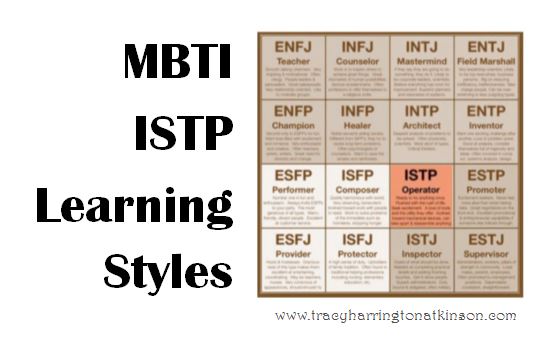ISTP (Introversion, Sensing, Thinking, Perceiving) Learning Style
Tolerant and flexible, quiet observers until a problem appears, then act quickly to find workable solutions. Analyze what makes things work and readily get through large amounts of data to isolate the core of practical problems. Interested in cause and effect, organize facts using logical principles, value efficiency.
~Excerpted from Introduction to Type®
by Isabel Briggs Myers
_______________________________________________
Frequency
| ISTP – | 5.4% of the total population |
| 8.5% of the male population | |
| 2.4% of the female population |
| Introversion (I) | 50.7% of the total population |
| Sensing (S) | 73.3% of the total population |
| Thinking (T) | 40.2% of the total population |
| Perceiving (P) | 45.9% of the total population |
_______________________________________________
The estimated frequency table was compiled from a variety of MBTI® results from 1972 through 2002, including data banks at the Center for Applications of Psychological Type; CPP, Inc; and Stanford Research Institute (SRI).
Learner Keyword: analytical and pragmatic1
Learner Question
ISTPs, while learning, address the question, “How does this work?”2
Learning Style
ISTPs are most interested in learning how the information will help them to achieve their goals and how things work. They learn best through practical application as well as active application. However, they are independent learners. ISTPs enjoy complex challenges and problem solving.
ISTPs like to investigate the small details and look at sequential information. They are most intrigued by logical and linear learning.
ISTPs are quick to apply learning and knowledge to their situations. The will devote themselves to learning until they master the content. Yet they are highly critical of themselves.
ISTPs are driving by a desire to learn skills and to be actively it to use.

For other learning styles: MBTI Learning Styles – A Practical Approach Available in paperback; Kindle; and pdf versions
Cognitive Environment
ISTPs need an active, hands-on learning environment. They enjoy detail work and independent working environments. However, clear guidelines are needed. Small group and partner work are effective for ISTPs but prefer to work independently.
ISTPs need opportunities to ask questions during class and to have a variety of activities. They are effective and efficient researchers.
ISTPs are most comfortable:
- Observing
- Being independent learners
- Creating relationships with the new knowledge
- Reflection
- Hands-on experiences and practical applications
- Reviewing knowledge
- Facts and figures over theory and abstract knowledge
ISTPs are least comfortable:
- Participating in group work
- Being the center of attention
- Any activity related to building interpersonal relationships
- Theory and abstract knowledge
- Seeing no immediate need for the information
- Lack of lesson objectives and guidelines
- Pointless or circular discussions and reasoning
- Being detail-oriented
Learn More:
For more information on teacher and classroom tips, learner tips, instructional strategies and assessment strategies, see MBTI Learning Styles: A Practical Approach or learn more on Udemy.
 Click on one of the sixteen personality types for more information:
Click on one of the sixteen personality types for more information:
Click on one of these dimension for more information:

For other learning styles: MBTI Learning Styles – A Practical Approach Available in paperback; Kindle; and pdf versions
For other learning styles: MBTI Learning Styles – A Practical Approach Available in paperback; Kindle; and pdf versions
References
Bonwell, C. & Eison, J. (1991). Active Learning: Creating Excitement in the Classroom. ERIC Digest. ERIC Clearinghouse on Higher Education, Washington, D.C
Career Assessment. (2017). The 16 Myers-Briggs Type Indicator Personality Types (MBTI personality types). Retrieved from: http://careerassessmentsite.com/tests/myers-briggs-tests/about-the-myers-briggs-type-indicator/the-16-myers-briggs-personality-types/
CPP, Inc. (2017). Linking MBTI® Personality Type to Learning Style – Strategies and Insights. Retrieved from: http://www.cppblogcentral.com/cpp-connect/linking-mbti-personality-type-to-learning-style-strategies-and-insights/
Defiance College. (2106). What’s Your Personality Type? Retrieved from: http://library.defiance.edu/learningstyles/myersbriggs
Gregory, G. (2008). Differentiated instructional strategies in practice: training, implementation, and supervision (2nd ed.). Thousand Oaks, CA: Corwin Press. p. 97-99.
Humanmetrics. (2017). Learning Styles. Retrieved from: http://www.humanmetrics.com/personality/learning-styles
Kiser, H. (2017). Choice board. Retrieved from: https://hillarykiser.blogspot.com/2012/10/choice-board.html?showComment=1491939410939#c9063789945839625994
Krafka, K. (2017) Learning Menus. Retrieved from: http://prescriptionforgiftedsuccess.weebly.com/learning-menus.html
Litemind. (2017). What is mind mapping? Retrieved from: https://litemind.com/what-is-mind-mapping/
Martinez, M. (2006). What is metacognition. Phi Delta Kappan, 64(10), 696-699.
Melvin, J. (2017). Personality Type as an Indicator of Learning Style. University of Rochester. Retrieved from: file:///C:/Users/Tracy/Downloads/JMelvinSGf13paper%20(2).pdf
Myers & Briggs Foundation. (2017). How frequent is my type? Retrieved from: http://www.myersbriggs.org/my-mbti-personality-type/my-mbti-results/how-frequent-is-my-type.htm
Myers & Briggs Foundation. (2017). Type and Learning. Retrieved from: http://www.myersbriggs.org/type-use-for-everyday-life/type-and-learning/
Myers, I. (1998). Introduction to Type: A Guide to Understanding Your Results on the MBTI Instrument. Consulting Psychologists Press.
Myers, I., McCaulley, M., Quenk, N. & Hammer, A. (2009). MBTI Manual: A Guide to the Development and Use of the Myers-Briggs Type Indicator Instrument. Consulting Psychologists Press.
Okoro, C. & Chukwudi, E. K. (2011). Metacognitive skills: A viable tool for self-directed learning. Journal of Educational and Social Research, 1(4), 71-76.
Pelley, J.W. (2008). The Success Types Learning Style Type Indicator. Retrieved from: Texas Tech University. https://www.ttuhsc.edu/som/success/lsti.aspx
Smith, C. V. & Cardaciotto, L. (2011). Is active learning like broccoli? Student perceptions of active learning in large lecture classes. Journal of the Scholarship of Teaching and Learning, 11(1), 53-61.
University of Texas. (2017). Experiential Learning. Retrieved from: https://facultyinnovate.utexas.edu/teaching/strategies/overview/experiential-learning
Western Nevada College. (2017). Personality Types and Learning. Retrieved from: http://www.wnc.edu/mbti/personality-types/
Tracy Atkinson is certified in Myers Briggs Type Indicator (MBTI) by CPP, Inc. The findings on learning styles derive from research, experience and observations.
Tracy Atkinson, a mother of six, lives in the Midwest with her husband and spirited dachshunds. She is a teacher, having taught elementary school to higher education, holding degrees in elementary education and a master’s in higher education. Her passions include researching, studying and investigating the attributes of self-directed learners. She has published several titles, including: The Art of Learning Journals, Calais: The Annals of the Hidden, Rachel’s 8 and Securing Your Tent. She is currently exploring the attributes of self-directed learners: The Five Characteristics of Self-Directed Learners.

Comments are closed